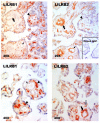Novel HLA-G-binding leukocyte immunoglobulin-like receptor (LILR) expression patterns in human placentas and umbilical cords
- PMID: 18538388
- PMCID: PMC2505055
- DOI: 10.1016/j.placenta.2008.04.007
Novel HLA-G-binding leukocyte immunoglobulin-like receptor (LILR) expression patterns in human placentas and umbilical cords
Abstract
Human placentas are sources of cytokines, hormones and other substances that program receptive cells. One of these substances is HLA-G, which influences the functioning of both leukocytes and endothelial cells. In this study, we investigated the possibility that these and/or other types of cells in extraembryonic fetal tissues might respond to HLA-G by interacting with one or another of the leukocyte immunoglobulin-like receptors (LILR). LILRB1 is expressed by most leukocytes and LILRB2 is expressed primarily by monocytes, macrophages and dendritic cells. Analysis of term placentas by immunohistochemistry and Real Time PCR demonstrated that LILRB1 and LILRB2 protein and specific messages are produced in the mesenchyme of term villous placenta but are differently localized. LILRB1 was abundant in stromal cells and LILRB2 was prominent perivascularly. Neither receptor was identified in trophoblast. Further investigation using double label immunofluorescence indicated that placental vascular smooth muscle but not endothelia exhibit LILRB2. Term umbilical cord exhibited the same LILRB2 patterns as term placenta. Samples obtained by laser capture dissection of vascular smooth muscle in umbilical cords demonstrated LILRB2 mRNA, and double label immunofluorescence showed that cord vascular smooth muscle but not endothelium exhibited LILRB2 protein. The presence of LILRB1 in placental stromal cells and LILRB2 in vascular smooth muscle strongly suggest that HLA-G has novel functions in these tissues that could include regulation of placental immunity as well as development and function of the extraembryonic vasculature.
Figures






Comment in
-
Investigation of an antibody reported to identify leukocyte immunoglobulin-like receptors (LILRB2) on placental vascular smooth muscle.Placenta. 2010 Mar;31(3):249-50. doi: 10.1016/j.placenta.2009.10.008. Epub 2009 Nov 13. Placenta. 2010. PMID: 19913297 No abstract available.
References
-
- Kovats S, Main EK, Librach C, Stubblebine M, Fisher SJ, DeMars R. A class I antigen, HLA-G, expressed in human trophoblasts. Science. 1990;248:220–23. - PubMed
-
- Morales PJ, Pace JL, Platt JS, Phillips TA, Morgan K, Fazleabas AT, Hunt JS. Placental cell expression of HLA-G2 isoforms is limited to the invasive trophoblast phenotype. J Immunol. 2003;171:6215–24. - PubMed
-
- Hunt JS, Petroff MG, McIntire RH, Ober C. HLA-G and immune tolerance in pregnancy. FASEB J. 2005;19:681–93. - PubMed
Publication types
MeSH terms
Substances
Grants and funding
LinkOut - more resources
Full Text Sources
Other Literature Sources
Research Materials

